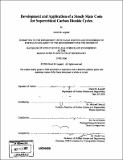| dc.contributor.advisor | Michael Driscoll and Pavel Hejzlar. | en_US |
| dc.contributor.author | Legault, David M. (David Michael) | en_US |
| dc.contributor.other | Massachusetts Institute of Technology. Dept. of Nuclear Science and Engineering. | en_US |
| dc.date.accessioned | 2008-05-19T15:58:47Z | |
| dc.date.available | 2008-05-19T15:58:47Z | |
| dc.date.copyright | 2006 | en_US |
| dc.date.issued | 2006 | en_US |
| dc.identifier.uri | http://hdl.handle.net/1721.1/41597 | |
| dc.description | Thesis (S.B.)--Massachusetts Institute of Technology, Dept. of Nuclear Science and Engineering, 2006. | en_US |
| dc.description | Leaf 63 blank. | en_US |
| dc.description | Includes bibliographical references (leaf 62). | en_US |
| dc.description.abstract | The supercritical CO2 power conversion system is of interest for advanced nuclear reactor applications because the same efficiencies are obtained as for the most developed of the closed gas-turbine cycles (helium-Brayton), but at lower temperatures and higher pressures. The original in-house code, named CYCLES, could potentially be used by others who are researching the S-CO2 cycle, but it has its shortcomings. In particular, CYCLES does not factor in the pressure drops due to pipes and plena. Also, for new users, it takes a significant amount of time to fully understand how to use the code. The objectives of this thesis were to modify CYCLES to ensure that pipe and plena effects were included, and to improve the readability and functionality of the code. Changes to CYCLES are included in the rewritten code, named CYCLES II, and are also documented in this thesis. Furthermore, documentation of the program input and output is given, along with a flow chart of the algorithm logic. Two applications of the code are provided to show the effect of the pipes and plena on cycle performance. In comparing the cycle efficiency with and without the effects of the pipes and plena, for a 300 MWe S-CO2 Brayton power conversion system, the results indicate that the net cycle efficiency drops from 49% to 45% when pipes and plena of reasonable dimensions are included in the calculations. The losses are dominated by the low pressure pipe and plena segments. However, the effects of the pipes and plena on cycle efficiency are not characteristic of the S-CO2 cycle only. All Brayton cycles have this same issue, and the effects are worse for the helium-Brayton cycle because it operates at lower pressures. | en_US |
| dc.description.statementofresponsibility | by David M. Legault. | en_US |
| dc.format.extent | 63 leaves | en_US |
| dc.language.iso | eng | en_US |
| dc.publisher | Massachusetts Institute of Technology | en_US |
| dc.rights | M.I.T. theses are protected by
copyright. They may be viewed from this source for any purpose, but
reproduction or distribution in any format is prohibited without written
permission. See provided URL for inquiries about permission. | en_US |
| dc.rights.uri | http://dspace.mit.edu/handle/1721.1/7582 | en_US |
| dc.subject | Nuclear Science and Engineering. | en_US |
| dc.title | Development and application of a steady state code for supercritical carbon dioxide cycles | en_US |
| dc.type | Thesis | en_US |
| dc.description.degree | S.B. | en_US |
| dc.contributor.department | Massachusetts Institute of Technology. Department of Nuclear Science and Engineering | |
| dc.identifier.oclc | 213817350 | en_US |
